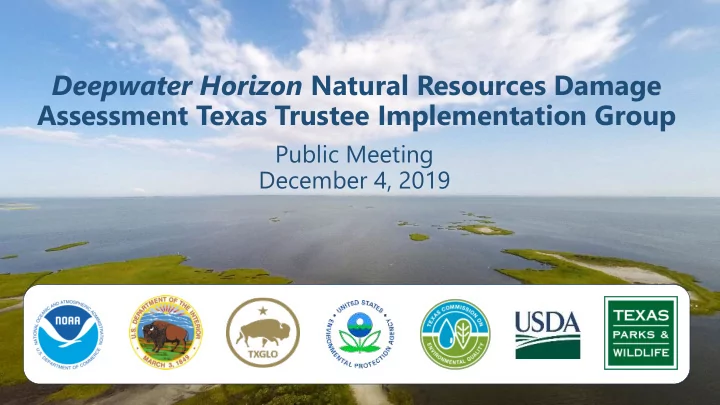

Deepwater Horizon Natural Resources Damage Assessment Texas Trustee Implementation Group Public Meeting December 4, 2019
Natural Resource Damage • Assessment and Restoration: An Introduction Texas Trustee Implementation • Group (TIG) Project Update Current Projects • Future Planning •
Legal process based on the Oil Pollution • Oysters Fish Birds Recreational Activities Wetlands Act (OPA) Trustees assess the degree to which natural • resources and the services they provide may have been injured by an oil spill and spill response activities Trustees determine how to compensate the • public through on-the-ground restoration activities
• Comprehensive and integrated ecosystem-level approach to restoring the Gulf of Mexico • Provides higher level guidance for identifying, evaluating, and selecting future restoration projects • Describes how TIG proposes to allocate restoration funding across geographic areas and different types of restoration activities
https://www.gulfspillrestoration.noaa.gov/restoration-areas/texas
Texas TIG Implementation Group Project Update
Texas Allocation of Restoration Funds Restoration funding allocated to the Texas Restoration Area for each restoration goal
Commitment of Restoration Funds Committed versus remaining restoration funding allocated for each restoration goal
Twenty (20) active projects along the Texas coast include: • Hydrologic and wetland restoration • Habitat acquisition • Park redevelopment and improvements • Oyster restoration • Artificial reef construction • Sea turtle restoration * Project numbers correlate • Rookery Island construction to NOAA Storymap IDs
• Sea Rim State Park Improvements • Indian Point Shoreline Erosion Protection • Laguna Atascosa Habitat Acquisition • Mid-Coast Habitat Acquisition • Bahia Grande Coastal Corridor Habitat Acquisition • Follets Island Habitat Acquisition • Oyster Restoration Engineering • Texas Gulf Coast Water Quality Restoration Planning
Location: Along the upper Texas coast in Jefferson County, Texas, southwest of Port Arthur, Texas Description: Constructed two wildlife viewing platforms, one comfort station, and one fish cleaning shelter in the park Benefits: Enhance visitor use and enjoyment of park resources
Location: Indian Point Park in San Patricio and Nueces counties Description: Constructs approximately 2,800 linear-feet of segmented breakwaters to stabilize the Corpus Christi Bay shoreline Status: Construction of 8 breakwaters is complete Synergy: Continues previous efforts to protect critical seagrass, coastal marsh, lagoons, and upland habitats from wind and wave-driven erosion
Laguna Atascosa Bahia Grande Coastal Corridor Completed Projects Laguna Atascosa: ~ 3,000 acres of beach, • dune, and tidal habitats Mid-Coast Habitat: ~690 acres of • predominantly estuarine wetlands Mid-Coast Habitat Follets Island On-going Projects Bahia Grande Coastal Corridor: ~ 1,300 • acres of habitat with 3 miles of frontage on the Lower Laguna Madre and Laguna Vista Cove Follets Island: ~300 acres of wetland and • coastal habitats
Description: Conducts an initial alternatives analysis to identify best management practices for rehabilitating oyster reefs buried by sediment and constructing intertidal oyster reefs within the Galveston Bay System Benefits: Results of the analysis will be used to develop location- specific engineering, design, and permitting documents for one or more oyster restoration projects
Nutrient Reduction Strategies Report Completed Purpose: To advance the Nutrient Reduction restoration goal identified in the PDARP by addressing eutrophication and its effects on the coast. Describes process and results of narrowing • down Texas coastal watersheds to those that provide the best opportunity to reduce nonpoint source nutrients Describes priority watersheds • Evaluates management strategies to reduce • nonpoint source nutrients that can cause eutrophication in a coastal watershed https://www.gulfspillrestoration.noaa.gov
Recommend
More recommend